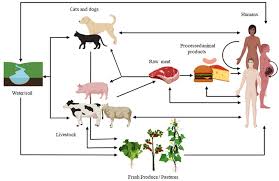Emerging Infectious Diseases in Livestock: Challenges and Strategies for Control
Abhishek Kumar, SK Maurya, DP Srivastava, Hemant Singh ,Amit kumar, SP Chakrborty
Introduction
Livestock infectious illnesses threaten worldwide animal health, food security, and economic stability. Viral, bacterial, parasitic, and fungal infections in livestock have spread rapidly in recent years. Many emerging infectious diseases (EIDs) can spread from animals to people, threatening human health as well as animal welfare. The complex interaction of global commerce, climate change, ecological disturbances, and human behaviour has increased cattle EIDs. Animal production systems’ intensification and globalization are major causes of livestock infectious illnesses. High-density animal populations, strict confinement, and long-distance animal movement make intensive farming ideal for disease transmission and amplification. International trade networks speed up cattle and animal product mobility, which helps spread infectious pathogens across borders.
Climate change also spurs cattle infectious disease outbreaks. Temperature, precipitation, and biological niches impact vector and reservoir host dispersion and disease transmission dynamics. Warming temperatures have expanded vector habitats, spreading vector-borne illnesses including Rift Valley fever and bluetongue virus in animals. Deforestation, urbanization, and habitat degradation affect natural ecosystems and animal habitats, increasing human-livestock-wildlife interaction. This contact allows infections to spread from wildlife reservoirs to domestic animals, potentially causing new infectious illnesses. Avian influenza, Ebola, and SARS are wildlife-borne zoonotic illnesses.
Epidemiology of Emerging Infectious Diseases in Livestock
Emerging infectious disease epidemiology in cattle is complicated and influenced by interactions between hosts, pathogens, and the environment. Globalization, climate change, and agricultural intensification are some of the factors that contribute to the evolution and spread of these illnesses. diverse illnesses have diverse host-pathogen dynamics and modes of transmission. Some diseases have the potential to spread to humans and animals through zoonotic agents. Effective monitoring and control strategies depend on an understanding of the regional and global patterns of disease dissemination. Emerging infectious illnesses in cattle can affect food security and supply systems, which can have significant negative economic effects. Moreover, their zoonotic potential emphasizes the significance of a One Health strategy, which combines the perspectives on environmental, animal, and human health to reduce risks and protect public health.
Impact on Livestock Production and Public Health
Infectious illness outbreaks in cattle have a significant effect on public health and productivity. In the cattle business, epidemics result in major financial losses due to lower production, trade restrictions, and the expense of disease management methods. Furthermore, these losses are made worse by interruptions to market access and supply chains, which have an impact on livelihoods and food security. Zoonotic illnesses provide a double risk to public health since they may spread from animals to people, possibly having catastrophic effects on epidemics. Furthermore, the animals’ wellbeing is jeopardized, which causes pain and raises ethical issues. In order to effectively address the impact of new infectious diseases in cattle, a comprehensive strategy that takes into account the interests of both public health and agriculture is needed. Effective surveillance, preventative measures, and multidisciplinary collaboration are particularly important.
Control Strategies
A multimodal strategy that incorporates several control measures is necessary to handle developing infectious illnesses in cattle. Systems for early detection and surveillance are essential for quickly recognizing epidemics and facilitating appropriate action. Vaccination campaigns and genetic resistance breeding provide long-term ways to improve herd immunity and lower the spread of illness. Strict biosecurity controls and quarantine guidelines must be put in place in order to stop infections from being introduced and spreading throughout farms. Adopting a One Health perspective, which unifies environmental, animal, and human health, encourages stakeholder engagement, and makes comprehensive disease management easier. However, obstacles like financial limitations and socioeconomic inequality could make it difficult to put these techniques into practice. Despite these challenges, increasing surveillance, strengthening biosecurity protocols, and promoting international collaboration are critical to reducing the burden of newly developing infectious illnesses in cattle.
Conclusion
Livestock infectious illnesses provide complex difficulties that require comprehensive management techniques. The complex relationship between globalization, climate change, intensive farming, and microbial evolution makes proactive actions necessary. These issues require surveillance, early discovery, swift response, and strong biosecurity. Collaboration between farmers, veterinarians, academics, politicians, and international organizations is essential for sharing knowledge, resources, and best practices. Innovative vaccinations, diagnostics, and treatments must also be researched to keep up with emerging infections. Integrating these techniques helps preserve animal health, food security, livelihoods, and global public health from new infectious illnesses. We must work together to address new cattle infectious illnesses.


